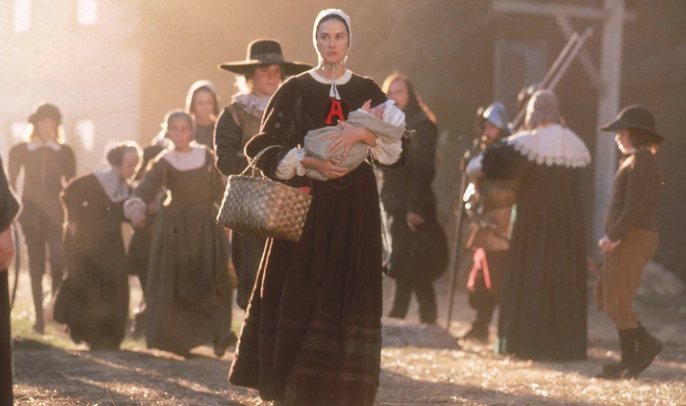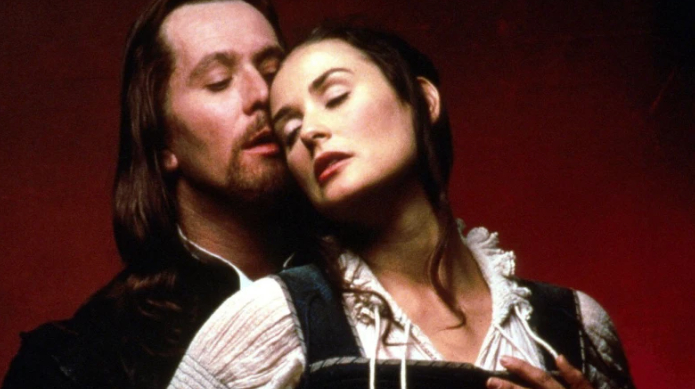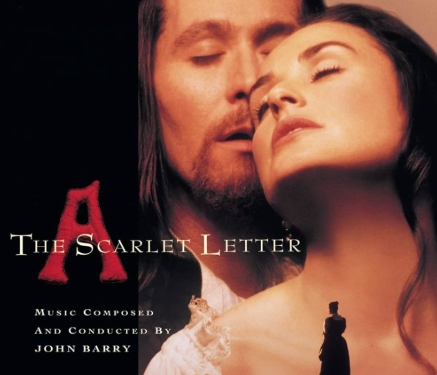The Scarlet Letter (1995)
“What if shame was a brand—and love, a crime?”
📖 Introduction: From Page to Provocation
Based on Nathaniel Hawthorne’s 1850 novel, The Scarlet Letter (1995), directed by Roland Joffé, is a lavish and polarizing adaptation that trades Puritan restraint for romantic rebellion. Starring Demi Moore, Gary Oldman, and Robert Duvall, the film is less a faithful translation of the American literary classic and more an audacious reinterpretation — a bodice-ripping period drama that shocked purists and intrigued audiences with its sensual liberties and sweeping cinematography.
At its heart, the film attempts to wrestle with the same eternal questions Hawthorne posed: guilt, judgment, hypocrisy — but it does so not in whispers, but with cinematic fire.
⚖️ Plot: Love in the Shadow of a Theocracy
Set in 17th-century Massachusetts, the story centers on Hester Prynne (Demi Moore), a fiercely independent woman who becomes an outcast after bearing an illegitimate child in a society ruled by religious orthodoxy. Her husband, presumed dead at sea, returns incognito as Roger Chillingworth (Robert Duvall) — and begins a quiet campaign of vengeance. Meanwhile, Hester’s secret lover, Reverend Arthur Dimmesdale (Gary Oldman), writhes in guilt, torn between his love and his religious authority.
Branded with a scarlet “A” (for “adulteress”), Hester becomes a living emblem of shame — but also of defiant love, as she refuses to name the father or renounce her child.

In this adaptation, however, Hester’s silence is not stoic—it’s impassioned, and her suffering is portrayed as something more sensual, more physical, and controversially, more heroic than in Hawthorne’s grim original.
🎭 Performances: Passionate, If Misplaced
Demi Moore, in one of her most daring roles, brings strength and fire to Hester — her Hester is not a passive victim, but a proto-feminist icon with striking independence. While her accent occasionally falters and the script gives her dialogue that feels modern, Moore delivers with conviction, balancing vulnerability with fury.
Gary Oldman, as Dimmesdale, is a tortured soul: charismatic, spiritual, yet overwhelmed by guilt. His chemistry with Moore is electric, and their romantic scenes are emotionally charged — even when they drift far from Hawthorne’s moral framework.
Robert Duvall is chilling as Chillingworth, bringing a quiet menace to the betrayed husband. With icy calm and sinister intent, Duvall’s portrayal suggests a man transformed not by grief, but by obsession.

🎥 Direction & Tone: Lush, Lustful, and Loose with the Text
Roland Joffé, known for The Killing Fields and The Mission, applies his talent for visual grandeur to early colonial America. The cinematography by Alex Thomson captures fog-drenched forests, candlelit interiors, and haunting coastline vistas that feel more cinematic than historical.
But the film’s tone wavers: at times it’s reverent, at others borderline erotic. There’s a sensuality—bordering on romantic fantasy—that redefines Hester and Dimmesdale’s relationship as liberating, rather than tragic. The infamous bathing scene, among others, drew criticism for its departure from Puritan rigidity into full-blown sensual cinema.
This is not Hawthorne’s New England. It’s a place where passion burns hotter than piety.

🎼 Music: A Score of Tragedy and Temptation
Composer John Barry (of Out of Africa and Dances with Wolves) delivers a gorgeous, melancholic score, layering the film with a sense of longing and foreboding. Strings swell beneath Hester’s defiance and Dimmesdale’s torment, infusing even the most controversial scenes with emotional grandeur.
✍️ Themes: Freedom, Feminism, and Fidelity (or the Lack Thereof)
While Hawthorne’s novel is a meditation on shame, secrecy, and inner torment, the film chooses a different narrative path — one that embraces:
- Female agency: Moore’s Hester refuses to be a symbol of guilt; she owns her choice.
- Romantic idealism: Love becomes redemption, not condemnation.
- Historical revisionism: The film reframes Puritanism less as internal struggle, more as external oppression.
These choices sparked backlash, but also brought fresh feminist interpretations that, while unfaithful to Hawthorne, gave 1990s audiences a lens into how historical fiction could be reimagined, not just re-enacted.

📉 Reception: Ambitious, Divisive, and Unapologetic
Critics were divided — some accused the film of turning classic literature into soft-core melodrama. Others admired its boldness, its attempt to humanize and modernize a story often trapped in academic analysis. It was a box office disappointment, but it has since gained minor cult status for its sheer audacity and style.
🧠 Final Verdict
The Scarlet Letter (1995) is not Hawthorne’s novel brought to life — it’s Hawthorne’s themes reinterpreted through a lens of 1990s sensuality, feminism, and cinematic ambition. It may not satisfy literary purists, but it challenges, provokes, and burns with its own feverish conviction.
If you’re seeking a faithful adaptation, look elsewhere. But if you’re open to seeing a classic transformed into a visual opera of rebellion and desire, this flawed yet fascinating film still has something to say.
Rating: 7.1/10
“Lush, defiant, and dangerously passionate — a literary heresy that dares to feel.”
#TheScarletLetter1995 #DemiMoore #GaryOldman #RobertDuvall #HawthorneReimagined #HistoricalDrama #FeministCinema #LiteraryAdaptation #RolandJoffe #90sCinema
